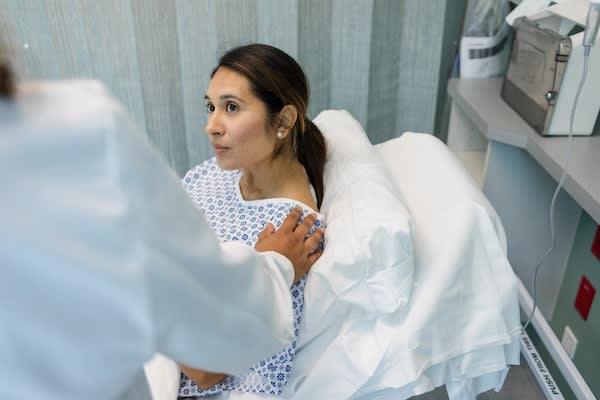
[8 MIN READ]
In this article:
-
Stevens-Johnson syndrome (SJS) is a rare disorder that causes your skin to develop rashes and blisters, and then peel. It can also affect your eyes, mouth and genitals. SJS is a medical emergency.
-
The most common cause of SJS is an allergic reaction to a medication, such as antibiotics, NSAIDs, and medications to treat seizures and mental illness. Infections like pneumonia, HIV, herpes and hepatitis A can also cause SJS.
-
SJS is treated in the hospital, where patients typically stay for a few weeks. It includes medications to relieve pain, stop infection and decrease inflammation. Wound care involves cool compresses, ointment and medicated bandages or dressings.
Stevens-Johnson syndrome: Causes, symptoms and treatment
Stevens-Johnson syndrome, or SJS, is a rare, serious skin disorder that needs immediate medical care. It typically affects children and adults under age 30.
What is Stevens-Johnson syndrome?
Stevens-Johnson syndrome, also called SJS disease or SJ syndrome, causes the skin to develop rashes and blisters, and then peel. It can also affect the mucous membranes, like your eyes, mouth and genitals. SJS is a medical emergency.
SJS vs. toxic epidermal necrolysis (TEN)
SJS is similar to toxic epidermal necrolysis (TEN), which is another serious skin peeling condition. SJS typically affects 10% or less of your body’s surface area and has a fatality rate between 1% and 10%. TEN affects 30% or more of your body’s surface, and about 25% to 30% of cases are fatal.
What causes Stevens-Johnson syndrome?
The most common cause of SJS is an allergic reaction to a medication or a bacterial infection. In some cases, doctors don’t know the cause.
Medication triggers
More than 100 different medicines can trigger Stevens-Johnson syndrome (which some people search for online as “steve and johnson disease”). The most common ones include:
- Antibacterial sulfa drugs
- Antibiotics
- Anti-gout medications
- Non-steroidal anti-inflammatory drugs (NSAIDs) like acetaminophen, ibuprofen and naproxen sodium
- Medications to treat seizures and mental illness (anticonvulsants)
According to Carter K. Haag, M.D., a dermatologist at Providence Dermatology – Reed’s Crossing, SJS from an adverse drug reaction typically happens within seven to 21 days of taking the medicine.
Infections and other risk factors
Infections like pneumonia, HIV, herpes and hepatitis A can also cause SJS. In children, the cold, flu or cold sores can trigger SJS as well.
Other risk factors include:
- Cancer: chemotherapy or radiation
- Family history: immediate blood relative who’s had SJS
- Genetic factors: certain genetic variations
- Personal history of SJS: higher likelihood of recurrence
- Weakened immune system: autoimmune diseases, HIV/AIDS, organ transplant or bone marrow transplant
Symptoms and warning signs
“The initial signs of SJS are flu-like symptoms,” Dr. Haag says. “You may have a fever, sore throat, muscle pains and painful skin.”
After a few days, skin and mucosal reactions occur. These can include:
- Blisters on your skin and mouth, nose, eyes, genitals and anus
- Red or purple rash that spreads
- Red, painful, watery eyes
- Skin peeling a few days after blisters form
- Swelling in your mouth, lips, throat, tongue or face
According to Dr. Haag, the rash starts as target-like lesions of various shapes and sizes. Then blisters appear, and the skin sloughs off, leaving behind open, raw skin.
Diagnosis and treatment
“SJS is a serious medical emergency that requires immediate attention in the emergency department,” Dr. Haag says. “That is followed by inpatient care, ideally at a hospital with access to specialists in dermatology, ophthalmology, urology and/or gynecology.”
To diagnose SJS, your health care provider will ask about your medical history, pain level and medications. They will examine you and may do other tests. These include:
- Blood test: to identify infection or other possible causes
- Chest X-ray: to check for pneumonia
- Skin biopsy or culture: to confirm diagnosis and rule out other causes
If you have SJS, you may stay in the hospital’s intensive care unit or a burn unit.
Hospital care and medications
Your doctor will have you stop taking the medication that may have triggered SJS. Treatment focuses on managing pain and preventing infection. It may include:
- Antibiotics to prevent or control infection
- Artificial tears and ointments to lubricate your eyes
- Cool compresses, ointment and medicated bandages or dressings to treat wounds
- Corticosteroids and IV immunoglobulin to limit disease progression
- High-calorie food or a feeding tube to promote healing
- IV fluids to replace electrolytes and prevent dehydration
- Medication to relieve pain
- Topical steroids to decrease inflammation of the eyes and mucous membranes
“A typical recovery from SJS may take two to four weeks,” Dr. Haag says. “Depending on the severity, some or even all of that time may be spent in the hospital. But there can be many chronic effects from SJS, some of which aren’t reversible.”
Potential complications and long-term effects
Most people recover from SJS, but some have life-threatening complications and long-term effects. In rare cases, SJS can be fatal.
Serious complications include:
- Acute respiratory failure when the lungs can’t get enough oxygen in the blood
- Blood infection (sepsis) when bacteria enter the bloodstream and spread throughout the body
- Multiple organ failure (such as your heart, liver, kidneys and lungs)
- Pneumonia
- Shock
Eye and skin damage
After you’ve recovered from SJS, you may have eye and skin issues. This includes inflammation, dry eyes, light sensitivity or painful ulcers. Your skin may be dry, itchy and discolored, and may have scars or bumps.
Other long-term effects may include:
- Changes to your sense of taste
- Chronic fatigue
- Dry mouth and difficulty swallowing
- Hair loss
- Increased sweating
- Mucous membrane dryness, which can cause problems urinating
- Nail loss or deformity
Emotional recovery and support
Approximately 50% of people who recover from SJS and TEN have depression and anxiety. Others have post-traumatic stress disorder (PTSD). Many are afraid to take any medication again.
It’s important to incorporate mental health support into your care. This can include:
- Counseling sessions with a psychologist, psychiatrist or social worker
- Relaxation therapy such as deep breathing or meditation
- Support groups
Other resources include:
- Genetic and Rare Diseases Information Center
- National Organization for Rare Disorders (NORD)
- Stevens-Johnson Syndrome Foundation
Can Stevens-Johnson syndrome be prevented?
Preventing SJS is difficult because it’s unpredictable. Of course, if you know which medication triggered SJS, don’t take it — or others like it — again. A second episode of SJS is often worse than the first.
Always tell your health care team if you’ve had SJS. Or wear a medical information bracelet or necklace with this information.
Asian people may have a genetic variation that increases their risk of SJS. Talk with your doctor about testing for this variation.
More health resources from Providence
Emergency medical care is necessary for Stevens-Johnson syndrome. Providence has experienced dermatology, ophthalmology and specialist teams that provide comprehensive, compassionate care for rare conditions like SJS.
Contributing caregiver

Carter K. Haag, M.D., is a dermatologist at Providence Dermatology – Reed’s Crossing in Hillsboro, Oregon.
Find a doctor
If you are looking for a primary care provider or dermatologist, you can search for one who’s right for you in our provider directory. You can also find out more about our dermatology services and mental health care.
Download the Providence app
It’s all in the app: easily stay connected with Providence and your health. With the Providence app, you can schedule appointments, have virtual visits from the comfort of your own home, get health recommendations personalized for you, access your health records and so much more. Learn more and download the app.
Related resources
Q&A with a Providence dermatology expert
RSV, flu & COVID: What you need to know
This information is not intended as a substitute for professional medical care. Always follow your health care professional’s instructions.
About the Author
More Content by Providence Health Team





















